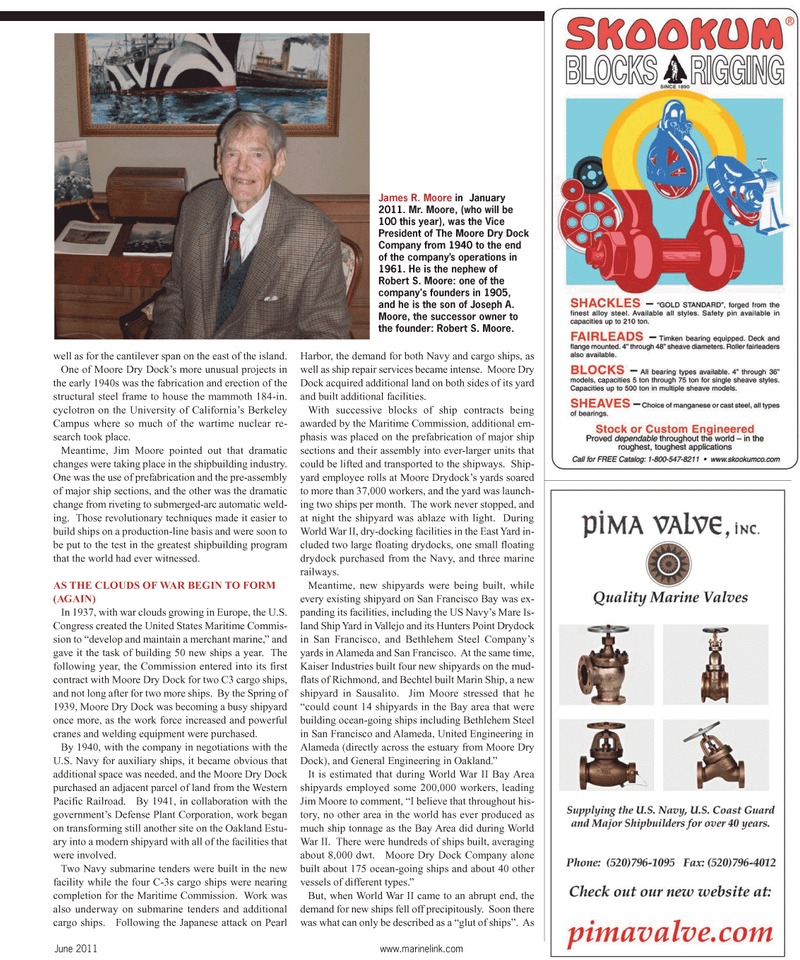
Page 75: of Maritime Reporter Magazine (June 2011)
Feature: Annual World Yearbook
Read this page in Pdf, Flash or Html5 edition of June 2011 Maritime Reporter Magazine
well as for the cantilever span on the east of the island. One of Moore Dry Docks more unusual projects in the early 1940s was the fabrication and erection of the structural steel frame to house the mammoth 184-in.cyclotron on the University of Californias Berkeley Campus where so much of the wartime nuclear re- search took place.Meantime, Jim Moore pointed out that dramaticchanges were taking place in the shipbuilding industry. One was the use of prefabrication and the pre-assembly of major ship sections, and the other was the dramatic change from riveting to submerged-arc automatic weld- ing. Those revolutionary techniques made it easier to build ships on a production-line basis and were soon to be put to the test in the greatest shipbuilding program that the world had ever witnessed. AS THE CLOUDS OF WAR BEGIN TO FORM (AGAIN)In 1937, with war clouds growing in Europe, the U.S. Congress created the United States Maritime Commis-sion to develop and maintain a merchant marine,? and gave it the task of building 50 new ships a year. The following year, the Commission entered into its first contract with Moore Dry Dock for two C3 cargo ships, and not long after for two more ships. By the Spring of 1939, Moore Dry Dock was becoming a busy shipyard once more, as the work force increased and powerful cranes and welding equipment were purchased. By 1940, with the company in negotiations with the U.S. Navy for auxiliary ships, it became obvious that additional space was needed, and the Moore Dry Dock purchased an adjacent parcel of land from the Western Pacific Railroad. By 1941, in collaboration with the governments Defense Plant Corporation, work began on transforming still another site on the Oakland Estu-ary into a modern shipyard with all of the facilities that were involved. Two Navy submarine tenders were built in the new facility while the four C-3s cargo ships were nearing completion for the Maritime Commission. Work was also underway on submarine tenders and additional cargo ships. Following the Japanese attack on Pearl Harbor, the demand for both Navy and cargo ships, as well as ship repair services became intense. Moore Dry Dock acquired additional land on both sides of its yardand built additional facilities. With successive blocks of ship contracts being awarded by the Maritime Commission, additional em- phasis was placed on the prefabrication of major ship sections and their assembly into ever-larger units that could be lifted and transported to the shipways. Ship- yard employee rolls at Moore Drydocks yards soared to more than 37,000 workers, and the yard was launch- ing two ships per month. The work never stopped, and at night the shipyard was ablaze with light. During World War II, dry-docking facilities in the East Yard in- cluded two large floating drydocks, one small floating drydock purchased from the Navy, and three marine railways. Meantime, new shipyards were being built, while every existing shipyard on San Francisco Bay was ex- panding its facilities, including the US Navys Mare Is- land Ship Yard in Vallejo and its Hunters Point Drydock in San Francisco, and Bethlehem Steel Companys yards in Alameda and San Francisco. At the same time, Kaiser Industries built four new shipyards on the mud- flats of Richmond, and Bechtel built Marin Ship, a new shipyard in Sausalito. Jim Moore stressed that he could count 14 shipyards in the Bay area that were building ocean-going ships including Bethlehem Steel in San Francisco and Alameda, United Engineering in Alameda (directly across the estuary from Moore DryDock), and General Engineering in Oakland.? It is estimated that during World War II Bay Area shipyards employed some 200,000 workers, leading Jim Moore to comment, I believe that throughout his- tory, no other area in the world has ever produced as much ship tonnage as the Bay Area did during World War II. There were hundreds of ships built, averaging about 8,000 dwt. Moore Dry Dock Company alone built about 175 ocean-going ships and about 40 other vessels of different types.? But, when World War II came to an abrupt end, the demand for new ships fell off precipitously. Soon there was what can only be described as a glut of ships?. As June 2011www.marinelink.com James R. Moore in January2011. Mr. Moore, (who will be 100 this year), was the Vice President of The Moore Dry Dock Company from 1940 to the end of the companys operations in 1961. He is the nephew ofRobert S. Moore: one of the company's founders in 1905,and he is the son of Joseph A.Moore, the successor owner to the founder: Robert S. Moore.

 74
74

 76
76
